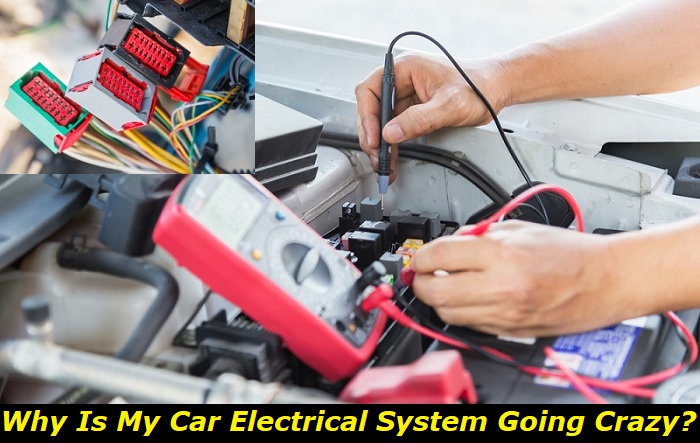Dimming or flickering lights, malfunctioning audio system, warning lights in the dashboard, hard starts, and performance issues could mean one or more things going on in the electrical system of your vehicle. However, due to its intricate design, problems in its components can be hard to diagnose at certain times. Sometimes, a problem in one part tends to lead to a network of issues, too, which can complicate matters.
Electrical gremlins highlights
- Level of urgency:medium
- DIY inspection:impossible
- DIY repair:impossible
- Can you drive?yes
- Price for repairs:$0 - $300
- Symptoms:glitch, unusual behavior, temporary problem
- Ways to solve:check the battery voltage, check wiring and connections, take it to a professional mechanic

Most Common Reasons for Electrical Problems in Cars
As mentioned earlier, electrical problems in cars may be tricky to diagnose in some instances as most of the parts involved trigger the same set of symptoms. Based on the advice of professionals though, here are the areas where they will most likely occur:
1. Battery
A car battery's primary and most crucial job is to deliver the energy needed by the engine and electrical system of your vehicle. When you turn the key or press the button to start the engine, the chemical energy stored in a battery is put to work and later converted to electrical energy.
The battery then distributes this electrical energy to all the parts of your car that might require it. Whenever you are diagnosing performance and electrical issues in your vehicle, this is the first part that you should check.
Before anything else, make sure that the battery cables and their connectors are installed properly. Next, see to it that your battery is not yet due for replacement and not showing any signs of damage. If everything checks well, test if it's still capable of holding a charge using a voltmeter while the engine is off. A reading of below 12.6 volts is a sign that your car already needs a new battery.
2. Alternator
The engine is incapable of generating electricity by itself since it is only mechanical in nature. Thus, it needs a medium to convert mechanical energy to electrical energy to power all the electrical equipment in your car, and this is where the alternator enters the picture.
The voltage regulator, alternator, and automobile battery make up the charging system of the vehicle. Using an alternating current, your alternator transforms mechanical energy into electrical energy. Alternators produce alternating electricity by rotating the stator and rotor, which function as magnets. The battery is then charged after the alternating current (AC) is changed into a direct current (DC).
If there's something wrong with your alternator, it can cause a lot of problems. For one, your car's electrical equipment may not work properly. Additionally, if the alternator is not charging the battery properly, it will eventually die. This can leave you stranded on the side of the road with a dead battery.
There are a few ways to tell if your alternator is going bad aside from the aforementioned electrical problems. A whining noise coming from the engine bay is an indication that the alternator bearings are going bad and need to be replaced. A voltage reading of below 13.8 volts in that part is also a sign of its need for a replacement.
If you think your alternator is faulty, the best course of action is to take it to a mechanic and have them check it out. They can run some tests to see if the alternator is indeed going bad. If it is, they can replace it with a new one.
3. Voltage Regulator
Since battery overcharging and undercharging both pose serious risks, the voltage regulator directs the energy from the alternator to the battery and regulates the flow of energy to give the battery a constant supply.
Since battery overcharging and undercharging both pose serious risks, the voltage regulator directs the energy from the alternator to the battery and regulates the flow of energy to give the battery a constant supply. It is important to keep the voltage regulator in good condition to protect the battery and other electrical components in your car.
If you notice that your car's electrical system is not functioning properly, it could be due to a faulty voltage regulator. To diagnose the problem, first, check the fuses and circuit breakers. If they are all intact, then test the voltage regulator with a voltmeter. If the readings are above the normal range of 14.5 volts, then the voltage regulator needs to be replaced.
4. Wiring Harness
One of the most common electrical issues in vehicles is a bad wiring harness. This can be caused by things like simple corrosion, loose connections, or damage.
Corrosion is one of the most common causes of bad wiring. This is because wires are constantly exposed to elements such as moisture and dirt, which can cause them to break down over time. To check for corrosion, simply inspect the wires for any signs of rust or discoloration. If you find any, you'll need to clean them with a wire brush or sandpaper to remove the corrosion. However, if the rusting has already eaten the metal parts of the wirings and connectors, the harness may need to be changed.
Loose connections are another common cause of electrical issues. This is because the connections between the wires and the components they're connected to can become loose as time goes. This can be due to several things, ranging from major vibrations to simply age. To check for loose connections, you'll need to visually inspect the wires and components. If you see any that are loose, you'll need to tighten them.
The continuity of wires is another important factor in electrical systems. This is because if there is a break in the electrical flow of the wires, it can cause an electrical issue. To test for continuity in each wire, you'll need to use a voltmeter. Simply attach the voltmeter to the two ends of the wire and check the reading for continuity.
If the reading is zero, then there is a break in the electrical path of the wire and you'll need to replace it or the entire harness if necessary. The same should be done if you notice any signs of major wear on the wires and their connectors like burn marks or fraying.
5. Fuse
The fuse is a critical component in the electrical system of a car. It ensures that the current flowing through the system is within safe limits. If the current exceeds the safe limit, the fuse will get burnt, interrupting the flow of electricity and preventing damage to the system.
Fuses can blow for a variety of reasons. The most common cause is a sudden increase in the amount of current flowing through the system. This can be caused by a short circuit or by connecting too many devices to the system at once. Another common cause of blown fuses is age. As time passes, fuses can become worn out and less able to handle normal levels of current.
If you suspect that a fuse has blown, the first thing to do is check the fuse box for any signs of damage. Similarly, see if any of them shows a value above 2 ohms when tested for resistance using a multimeter. Replace any faulty fuse that you can find with a new one of the same size and rating.
6. Sensors
A faulty sensor can disrupt the electrical system of a car. The most common symptom of a faulty sensor is an engine that stalls or doesn't start. Other symptoms can include poor fuel economy, strange noises from the engine, and sudden changes in engine speed.
To diagnose the possible causes of a malfunctioning sensor, first, check the wiring harness for any loose or damaged wires. Next, check the connectors to make sure they are clean and free of corrosion. Finally, test the sensor itself with a multimeter to see if it is functioning properly.
If the wiring harness and connectors are all in good condition, then the problem is likely with the sensor itself. In this case, you will need to replace the sensor. Be sure to get a sensor that is compatible with your car's make and model.
If you are having trouble diagnosing the problem, or if you need to replace multiple sensors, it is best to consult a professional mechanic. They will be able to quickly diagnose the problem and get your car back on the road.
7. PCM
The PCM serves as the brain of your car, which is responsible for processing and managing the data it receives from the different onboard sensors of your car. The information it gathers is used to optimize the performance of the engine, gearbox, and other components.
Just like any other computer though, the PCM or the powertrain control module is prone to glitches. If this happens, it can drive the electrical system of your car crazy.
If the problem is only confined to a software issue within the PCM, a car technician will probably be able to fix the problem through the process called "reflashing" or "flashing". Simply put, reflashing is updating your car's computer within its maker's recommended settings. However, if the hardware of the part is already damaged, you may be in for a pricey replacement.
Conclusion
Car electrical system problems can be as simple as a loose or dirty connection. However, in many cases, they can also relate to damaged parts. Whichever is the reason, it should be diagnosed and fixed right away to prevent more expensive repairs arising from their negative effects.
About the authors
The CarAraC research team is composed of seasoned auto mechanics and automotive industry professionals, including individuals with advanced degrees and certifications in their field. Our team members boast prestigious credentials, reflecting their extensive knowledge and skills. These qualifications include: IMI: Institute of the Motor Industry, ASE-Certified Master Automobile Technicians; Coventry University, Graduate of MA in Automotive Journalism; Politecnico di Torino, Italy, MS Automotive Engineering; Ss. Cyril and Methodius University in Skopje, Mechanical University in Skopje; TOC Automotive College; DHA Suffa University, Department of Mechanical Engineering






Add comment